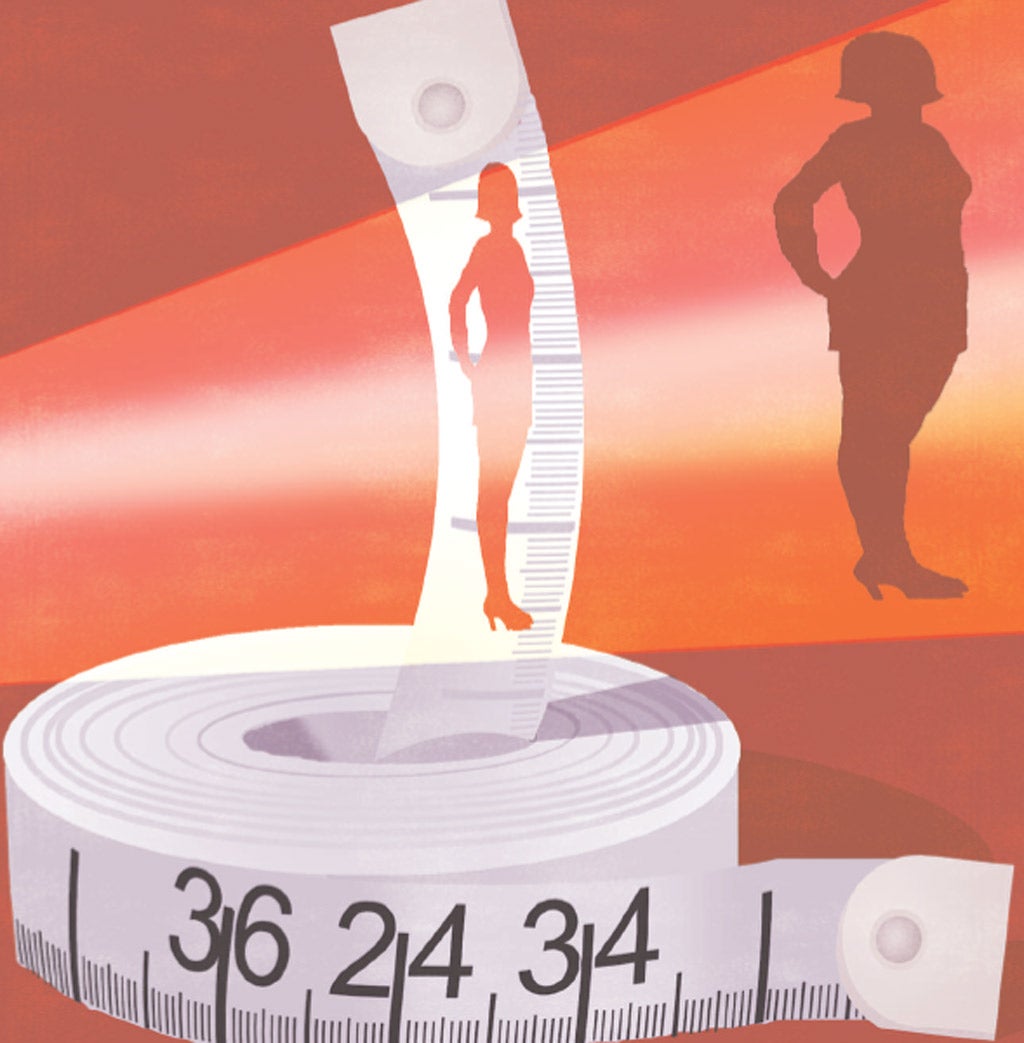Mary Ann Sieghart: What women see in the mirror is self-hatred
Women feel depressed because the 'ideal shape' is almost as remote from reality as Barbie's


Your support helps us to tell the story
From reproductive rights to climate change to Big Tech, The Independent is on the ground when the story is developing. Whether it's investigating the financials of Elon Musk's pro-Trump PAC or producing our latest documentary, 'The A Word', which shines a light on the American women fighting for reproductive rights, we know how important it is to parse out the facts from the messaging.
At such a critical moment in US history, we need reporters on the ground. Your donation allows us to keep sending journalists to speak to both sides of the story.
The Independent is trusted by Americans across the entire political spectrum. And unlike many other quality news outlets, we choose not to lock Americans out of our reporting and analysis with paywalls. We believe quality journalism should be available to everyone, paid for by those who can afford it.
Your support makes all the difference.A cute little naked baby is grinning at the camera. "Is this the happiest she'll ever be about her appearance?" asks the slogan on the billboard. The ad was for a campaign last year to save future generations of women and girls from hating their bodies. For the explosion in cosmetic surgery – and explosion of breast implants inside women's bodies – is just a symptom of a corrosive unhappiness that begins only a few years after birth.
Three British psychologists have studied the effect of Barbie dolls on five- to eight-year-old girls. Barbie is ubiquitous – 99 per cent of American girls own at least one of her. Yet if Barbie were a real woman, her waist would be 39 per cent smaller than the average anorexic patient, and she would be far too thin to menstruate. Despite this skeletal state, she miraculously has big breasts. It is a body shape so unattainable that the chances of a woman naturally having her proportions are less than one in 100,000. And guess what? The girls in the study who played with Barbie became more dissatisfied with their own bodies and were more likely to say they wanted to be thinner than the girls who were given a normal-shaped doll to play with.
Is it surprising, then, that the average age at which girls start dieting is now eight? Or that the Barbie effect does not wear off? According to an American study, adult women who look at thin models in advertisements take just one to three minutes to feel worse about their bodies than they did at the start. A control group who were shown only the products without the models experienced no change in mood.
Women feel depressed because the ideal shape to which they are constantly exposed is almost as remote from reality as Barbie's. For a start, even the models – who are chosen for their preternatural proportions and beauty – don't look in real life as they appear in the ads. Their skin has been made flawless by airbrushing, their legs lengthened, waists narrowed and curves enhanced by digital manipulation.
Then, of course, there is the surgical work. Models have got thinner and thinner over the past few decades and, as all women know, if you lose weight your breasts get smaller too. It's almost impossible to be stick-thin and have big boobs – unless you go under the knife.
So the "ideal" shape for a woman has become physically unattainable, however little she eats or however much she exercises. She can hope to achieve it only by having silicone in the shape of chicken fillets inserted surgically, and potentially dangerously, into her breasts.
This freakish ideal is everywhere we look. I took my 11-year-old niece to Topshop last week and, just as I was expounding to her the merits of curves, we caught sight of a mannequin with hideously skinny and impossibly long legs. Fashion mannequins are now six inches taller than the average British woman – in heels, they measure over six feet. Yet they are usually only a size 8 to 10. In other words, the models that gaze out of every shop window are unrealistically tall and thin. No wonder they make girls and women feel short and fat.
An international survey sponsored by Dove a few years ago found that British women were the third-most dissatisfied with their bodies, after those in Japan and Brazil. Some 68 per cent of women agreed that "the media and advertising set an unrealistic standard of beauty that most women can't ever achieve". At least three-quarters wished female beauty was portrayed in the media as consisting of more than just physical attractiveness and that the media did a better job of portraying women of diverse ages, shapes and sizes.
It can be done. Dove itself ran a campaign with normal-sized and older women, and the sales of its products soared. Advertisers and magazine editors are always claiming that their buyers and readers prefer this unnatural ideal shape. They usually call it "aspirational" as if it were even possible to aspire to. Yet not just Dove, but also two psychologists – Phillippa Diedrichs and Christina Lee – have now proved them wrong.
Diedrichs and Lee created a series of ads for underwear, a haircare product and a party dress. Each ad was made twice – once with a size-8 model and once with a size-12. The women who were shown the ad with the larger model not only found it as effective but felt better about their own bodies afterwards. An experiment with men had similar results.
For it's not just women who suffer. Only last week, a survey showed that men too feel insecure about their bodies. But at least the remedy for them – going to the gym – is less unhealthy than starvation or surgery, which many women endure.
So what can be done to stem the self-hatred that leads so many women to have their bodies mutilated? For a start, we must resist the trend towards cosmetic surgery being normalised. It's shocking that we allow television programmes showing ordinary people going under the knife in an attempt to look younger. How can we then be surprised that 40 per cent of teenage girls say they have considered plastic surgery? Cosmetic surgery is now the third-most popular reason for taking out a loan, after home improvements and buying a car.
With any luck, the implant scandal will make people think twice before undergoing such drastic procedures. And the sector certainly needs stricter regulation. But we in the media should examine ourselves too. Why does the BBC sack older female presenters in favour of thin, young ones with big tits? Why are the female judges in talent shows always younger, more pneumatic and more glamorously dressed than the men? What message does that send to viewers – that men are chosen for their authority and women for their "phwoar" factor?
When Tessa Jowell was a minister, she was ridiculed for suggesting to magazine editors that they use less grotesquely thin models. Now there is an All Party Parliamentary Group on Body Image, which will be taking evidence from the cosmetic surgery industry next Monday. Things are at last starting to move. We need a far more diverse range of role models, from gorgeously voluptuous to tomboy-thin, from young and fresh to old and distinguished. People come in all shapes, sizes and colours, and so does beauty. This obsession with one narrow ideal is doing not just our heads in but our bodies too. It is time to drop the artifice – the airbrushing, the manipulation, the surgery – and get real.
Join our commenting forum
Join thought-provoking conversations, follow other Independent readers and see their replies
Comments